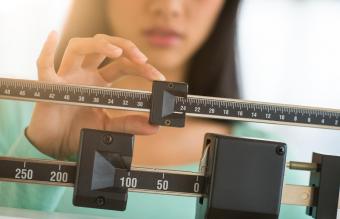
One of the better ways to set realistic weight loss goals is by utilizing information received from the ideal weight calculator. Eating healthy and exercising are ways to achieve the ideal weight indicated by the calculator.
Ideal Weight Calculator
In previous years, various inaccurate and unrealistic methods were used to gauge what one's proper weight should be. Tables derived from insurance statistics became the norm for weight standards. The problem with these tables is that frame size, among other factors, was never taken into account when figuring weight ranges. The "ideals" presented by these tables were a one-size-fits-all fix that didn't work appropriately for all people.
Factors to Consider
When figuring one's ideal weight, several factors should be considered. Not only should one's height be considered, but frame size, gender and age are also important factors relative to healthy weight maintenance.
Common sense tells us that someone with a larger bone structure is going to naturally carry more weight than a person with a smaller bone structure. To tell if you have a small bone structure, wrap your fingers around your wrist. If your fingers overlap, then you have a small frame. If your fingers meet, then you have a medium frame. If your fingers don't touch, then you are large framed.
Age is certainly a factor with healthy weight maintenance. As people age, it's a normal trait to carry a bit more weight. The ideal weight calculator takes age into account when making calculations and adds extra pounds for appropriate age levels.
Gender is a factor because men's and women's body make-ups are entirely different. Women naturally carry more fat than men do, so their healthy weights vary accordingly.
Where to Find It
One such Ideal Weight Calculator figures your ideal weight plus your Body Mass Index. The fault with this calculator is that it does not take your age into account.
The ideal weight calculator at Calculator.net delivers your ideal weigh according to a comparison of four popular formulas.
Changing Shape provides calculators for both men and women, in addition to tables with appropriate weight ranges.
With concern heightening for childhood obesity, this ideal weight calculator works for children. Once the calculations are reported, they are also analyzed and show different options for a child. There are guidelines for being overweight and underweight, in addition to links to body mass index calculators. Information on this site also indicates that overweight children may naturally slim down as they grow taller, but still makes parents aware of any issues that may be at hand for the child being evaluated.
Not The Only Measure
The ideal weight calculator is not the only unit of measure to determine whether or not one is at a healthy weight. Doctors are looking more and more to the body mass index. Additionally, underwater weighing, dual x-ray absorptiometry (DEXA, bioelectrical impedance and skin fold testing are currently utilized to determine healthy weights for adults. Hydrostatic weighing and DEXA are deemed the most accurate methods, but they also require the most expensive equipment. Experts agree that bioelectrical impedance is convenient as it is portable and accurate within 3 to 5 percent of more effective methods. Skin folds are probably the most convenient method of testing the body for its fat level. However, accuracy is determined by the level of expertise of the practitioner.
As always, when starting a diet plan, you should always consult your physician. They should be able to help you pinpoint your target weight, refer you for consultation with a dietician and assist you through your weight-loss endeavor. If you think you are at a healthy weight, the ideal weight calculator can be a good method to reassure you in your self-diagnosis.







